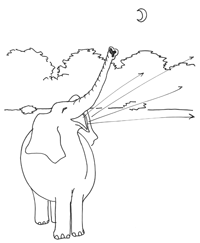STRANGEBUTTRUE- Sound principles: How to trumpet love and hate

DRAWING BY DEBORAH DERR McCLINTOCK
Q. How do tigers and elephants employ sound principles of physics to attract a mate or scare off a competitor? –Dumbo
A. A tiger's roar extends into the "infrasound" range, below what is audible to humans, says Jearl Walker in The Flying Circus of Physics. This low-frequency call not only sounds scarier but also travels farther, being absorbed and scattered less by trees and grass.
Elephants on a savanna will call out nearly twice as often at night, putting much of their energy into sound between 14-35 hertz, which extends into infrasound. Anyone near a calling elephant might feel the wave more than hear it. Because of nighttime atmospheric inversions– warmer air lying over cooler air– the elephants' low-frequency calls are effectively "trapped," traveling up to 10 kilometers (6.2 miles) instead of only a few during the day. (Higher frequency calls wouldn't go nearly as far.)
The best calling time is an hour or two after sunset, when the wind is low and an inversion has had time to develop. Later, the wind might pick up and carry the sound even farther but only in the wind's direction, failing to maximize overall sound spread. Somehow the savvy elephants know better.
Q. When might the act of waking up bring such joy and exquisite relief that you feel as if you've been reborn? –R.V. Winkle
A. That's the way Stanford University pioneer sleep researcher Dr. William Dement described his awakening from an exceptionally vivid and realistic nightmare where he had inoperable cancer of the lung, stemming from his long-time, two-pack-a-day habit.
"I remember as though it were yesterday looking at the ominous shadow in my chest X-ray and realizing that the entire right lung was infiltrated. I experienced the incredible anguish of knowing my life was soon to end, that I would never see my children grow up, and that none of this would ever have happened if I had quit cigarettes when I first learned of their carcinogenic potential." When Dement awoke, he vowed to stop smoking– and he did.
Almost everyone has experienced dreams of anxiety or fear, says Craig Webb of the Dreams Foundation (dreams.ca). Fear of nightmares per se can end up blocking dream recall, yet this can usually be overcome by learning about the useful nature of dreams and by recognizing that many nightmares– like a bitter but quite necessary medicine– represent opportunities for insight and healing.
Q. Why do karate experts break a stack of thin wood planks rather than one thick one? –P. Bunyan
A. The energy absorbed in breaking a single thin plank is very small, so not much more energy is needed to break more of them, says Keith Lockett in Physics in the Real World. When a thin plank is broken, the underside is stretched with nothing to counter it, whereas a thick plank has other layers of wood that resist the extension.
Even a stack of a hundred sheets of paper-thin wood would break
fairly easily. Karate training stresses the need for hand speed, since the equation for energy delivered by the fist is 1/2 times mass times velocity times velocity again. This squaring of velocity means that fist speed is especially critical.
"Whether the outlandish cries that accompany the blows have any effect, I leave to you," says Lockett.
~
Send Strange questions to brothers Bill and Rich at [email protected]
#